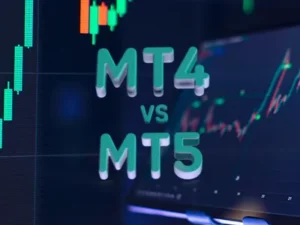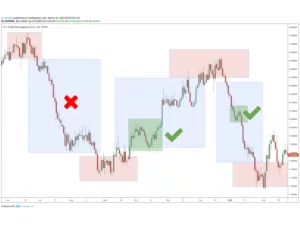In India, forex and crypto trading are moving toward automation and data-driven decisions. AI-based platforms now analyze market data, track news, and execute trades without emotions. They help traders react faster, reduce human error, and test strategies automatically. The technology is not only for professionals — retail traders can now access tools once used only by institutions.
You select Bitcoin and EUR/INR pair. You set an AI bot to buy when the RSI crosses 40 from below and sell when it crosses 70. The bot follows this rule, trades automatically, and records each result. At the end of the week, you review performance — number of trades, win rate, and total return. You can then adjust parameters (like stop-loss or entry level) and let the AI retest. This process builds consistent discipline and removes emotional mistakes.
Entry-Level Testing and Retesting
Once your first AI trading strategy is set up, start with entry-level testing on small trade sizes or demo accounts. This allows you to observe how the AI behaves under real market pressure without risking much capital. After collecting data from at least 20–30 trades, analyze your results carefully — note where entries were late, exits were too early, or drawdowns exceeded expectations. Then, make small adjustments to your rules (like changing timeframes or stop-loss distance) and let the AI retest automatically.
This cycle of test → review → refine → retest helps build consistency and removes emotional decision-making. Over time, you’ll start developing a data-backed understanding of what works and what doesn’t, leading to smarter, more confident live trading.
Why AI Platforms Are Growing in India
India’s trading landscape is rapidly modernizing, and AI is at the center of this transformation. With better internet infrastructure, faster computing, and access to global exchanges, traders now have the tools to use AI efficiently for both forex and crypto trading.
Fast Analysis and Automation
AI platforms analyze hundreds of charts and markets simultaneously, something impossible for a manual trader. They process historical data, technical indicators, sentiment analysis, and even global news to identify potential trading opportunities. Within seconds, AI systems can highlight trade setups that would take hours to find manually.
For Indian traders, this speed and automation mean they can manage forex, crypto, and even stock trades without monitoring markets all day. The AI handles scanning and alerting, allowing traders to focus only on strategy refinement and decision-making.
Benefits for Traders
AI trading platforms provide clear, measurable advantages that directly improve performance and efficiency.
Key advantages include:
- Continuous market scanning 24/7 – No downtime, ensuring that no major trade opportunity is missed.
- Instant alerts for entry and exit signals – Traders receive real-time notifications based on pre-set conditions.
- Automatic execution with fixed rules – Orders are placed automatically when strategy conditions are met, reducing delay and slippage.
- Emotion-free decision-making – AI doesn’t panic, overtrade, or hesitate, making it ideal for consistent execution.
- Detailed trade history and statistics – Every trade is logged with full metrics, helping traders review and refine strategies with precision.
By combining data-driven automation with transparent performance tracking, Indian traders can scale their trading activity efficiently while reducing emotional errors and fatigue.
Key Features to Check Before Choosing an AI Platform
Selecting the right AI platform is essential for both profitability and safety. Not every platform offers full functionality or legal compliance in India, so traders should verify both features and regulations before starting.
A reliable AI trading platform should include:
- Real-time data feeds for forex, crypto, and equities to ensure accurate signals.
- Customizable trading rules that allow you to set entry, stop-loss, and exit parameters.
- Automatic execution and order management to handle trades even when you’re offline.
- Backtesting tools that allow you to test your strategy on historical data before going live.
- Strong data security and two-factor authentication (2FA) for safe account access and protection of trading credentials.
- Performance analytics dashboard for tracking success rate, average trade duration, and profitability trends.
- Cloud or VPS support to ensure stable bot operation even during internet interruptions.
Before committing, always test the platform in demo mode and verify if it supports INR payments, SEBI-regulated brokers, and local customer support. This ensures both compliance and ease of use for Indian traders.
Comparison Table of Popular AI Platforms in India
| Platform Name | Supported Assets | AI Features | Regulation | Notes |
|---|---|---|---|---|
| Klypto.ai | Crypto | Auto bots, ML signals | Global | New crypto AI app for Indian traders |
| Mudrex | Crypto | Copy AI strategies | SEBI compliant partner | Offers pre-built portfolios |
| MetaTrader 5 + AI plug-ins | Forex | Custom ML scripts | Regulated brokers | Supports Python integration |
| Binance Auto Bot | Crypto | Grid + AI bot | Global | Works with API integration |
| Quant Insti Blitz | Forex/Crypto | Algo + AI toolkit | Based in India | Educational and live trading tools |
Artificial Intelligence (AI) is reshaping how traders build and execute trading systems. Instead of relying solely on manual analysis, traders can automate decision-making through coded logic, statistical learning, and data-driven models. However, successful AI trading doesn’t happen overnight — it requires clear structure, consistent testing, and data-backed refinements. The process involves defining clear trading rules, running controlled simulations, and monitoring results for accuracy and profitability.
Step-by-Step Practice
- Define Your Trade Rules — Start by setting clear rules for entry, stop-loss, and take-profit levels. These can be based on technical indicators (RSI, MACD, Moving Averages) or price action signals. For example: “Buy when RSI crosses above 40 and price breaks above a 20-period moving average.”
- Choose a Suitable Platform — Use platforms that support AI trading parameters like MetaTrader 5, TradingView, QuantConnect, or cTrader Automate. These allow backtesting and forward-testing with historical and live data.
- Run in Demo Mode for 20–30 Trades — Practice in a demo environment first. Test the bot across multiple pairs or assets such as forex and crypto. This helps understand its performance in varying volatility levels.
- Record Performance Metrics — Keep detailed records of every trade, noting win rate, average profit/loss, drawdown, execution time, and slippage. Metrics help you measure the AI’s reliability and efficiency.
- Refine Rules Monthly Based on Data — Adjust your parameters every 30 days based on observed performance. For instance, you might shorten stop-losses if drawdown is too high or change entry timing if profits are inconsistent.
Testing in controlled conditions helps identify how AI handles risk, adapts to different markets, and reacts to fast price movements. Over time, this process builds a strong foundation for live trading with minimal emotional bias.
| Metric | Result | Comments |
|---|---|---|
| Trades Executed | 30 | 15 forex, 15 crypto |
| Win Rate | 62% | Stable across both markets |
| Average Gain per Trade | 2.3% | Slightly lower for crypto |
| Max Drawdown | 8% | Within acceptable risk tolerance |
| Execution Delay | < 1 second | Excellent for automated setups |
This type of report provides a clear overview of system performance over a defined testing period. It helps traders see how their AI strategy behaves under different market conditions — from high volatility to consolidation phases. Beyond win rate and drawdown, other useful metrics include Sharpe ratio, profit factor, and expectancy, which offer deeper insight into the quality and consistency of returns.
Challenges in Using AI Platforms
AI tools offer powerful automation capabilities, but they also introduce new challenges that every trader must recognize. Many traders lose money not because their strategy is bad, but because they fail to understand how their AI behaves under real-world market stress. Proper testing and oversight are essential for maintaining long-term success.
Main Issues Traders Face
- Unreliable Data or Untested Models — Low-quality or outdated data leads to inaccurate signals and unpredictable trade outcomes. Always use trusted brokers that provide verified real-time feeds.
- Internet or Server Latency — In India, inconsistent network speeds or VPS delays can cause late order execution, which affects accuracy during volatile sessions. Using a low-latency hosting service helps mitigate this issue
- Over-Dependence on Automation — AI systems can’t interpret sudden news events like policy changes or flash crashes. Full automation without supervision can lead to heavy losses during such events.
- Fake AI Apps — Many “guaranteed profit” bots claim to deliver fixed returns but are often scams. These can misuse personal data, manipulate trades, or even steal funds. Always check developer credentials, platform reviews, and SEBI compliance before trusting any tool.
Tips to Reduce Risk
Before activating any AI trading system, follow this essential checklist to minimize risk and ensure proper control:
- Use only verified and regulated platforms — Always trade through brokers and exchanges approved by SEBI or recognized international regulators.
- Start small or use demo mode — Begin testing with minimum capital or virtual funds until the strategy produces consistent and stable results.
- Review logs weekly — Regularly inspect trade logs and system activity to detect any irregularities in order execution or trade logic.
- Pause automation during major news releases — Events like RBI rate decisions, inflation data, or U.S. economic reports can trigger unpredictable volatility. Disable bots temporarily to protect capital.
- Backup and update your strategy regularly — Market conditions change, and old parameters may no longer perform well. Updating your algorithm monthly keeps it relevant.
AI should always act as a decision support system, not a replacement for trader judgment. Traders must remain actively involved — monitoring performance, refining rules, and making strategic adjustments. When used responsibly, AI can multiply efficiency and precision, but without supervision, it can magnify mistakes just as quickly.
How to Combine AI and Manual Trading
Combining human judgment with AI automation produces the most reliable results. AI is best used for scanning markets, detecting patterns, and providing alerts, while human traders handle timing and risk control.
Smart Workflow
AI handles repetitive tasks such as backtesting, signal scanning, and technical calculations. Traders, in turn, confirm signals, adjust trade sizes, and manage open positions. For example, you can let the bot detect breakout zones or trend reversals, but you make the final decision based on risk and market sentiment.
This approach allows traders to benefit from AI speed and precision while keeping the flexibility of human reasoning — especially useful during unpredictable events or low-liquidity conditions.
The Future of AI Trading in India
India is moving toward a more technology-driven financial landscape. With advancements in automation and SEBI’s growing support for algorithmic trading, AI systems will soon become integral to both professional and retail traders.
- Wider use of AI-driven retail trading tools — Platforms like Dhan, Upstox, and Zerodha are exploring algorithmic modules for Indian traders.
- Integration of chat-based AI assistants — Future apps may allow traders to analyze charts and place trades using natural language commands.
- Use of on-chain and sentiment analysis data — Crypto traders will rely on AI tools that assess social media sentiment and blockchain analytics for better predictions.
- Growth of AI education and training programs — Platforms like QuantInsti and AlgoTrader India are already teaching coding, data analysis, and quantitative strategy design.
- Expansion of cloud-based algo hosting — Brokers will offer VPS and AI bot hosting services to improve uptime and reduce latency issues.
AI will soon become a standard part of the trading toolkit for Indian investors. Traders who learn how to test, monitor, and adjust AI systems will gain a clear advantage. The key is not just using technology but understanding how it behaves in changing markets.
FAQ
What is an AI-based trading platform?
It is a system that uses algorithms or machine learning to analyse prices, generate signals, and sometimes execute trades automatically.



